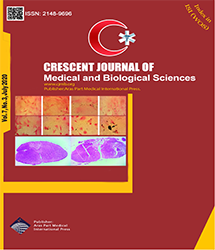| Original Article | |
| Leptin and Resistin Levels in Iranian Children With Type 1 Diabetes Mellitus | |
| Lida Saboktakin1 | |
| 1Pediatric Health Research Center, Department of Pediatrics, Tabriz University of Medical Sciences, Tabriz, Iran | |
|
CJMB 2020; 7: 368-372 Viewed : 4441 times Downloaded : 2968 times. Keywords : Leptin, Resistin, Diabetes mellitus |
|
| Full Text(PDF) | Related Articles | |
| Abstract | |
Objectives: Diabetes mellitus (DM), as a metabolic disorder, affects life quality through insulin insufficiency. Leptin and resistin are two adipokines that are mainly produced as internal secretory proteins by the adipose tissue. Considering that adipokines are strongly associated with insulin sensitivity and inflammatory markers, any modification in their serum levels is probably assumed to contribute to the pathogenesis of type 1 diabetes mellitus (T1DM) as well. Materials and Methods: The study was conducted on a population of diabetic children who were followed up during 2015 at the Pediatric Endocrinology and Metabolism Unit of Tabriz University, Faculty of Medicine. In general, 50 children with T1DM and 50 healthy control were selected in this regard. The exclusion criteria included hypertension, hyperlipidemia, anemia, or infection. Resistin and leptin levels were measured in the serums of children over a one-year period. Then the serum levels of leptin and resistin were measured and matched for gender, age, and body mass index (BMI), followed by measuring the correlations (adjusted for age and gender) between the serum levels of adipokines and either BMI or glycemic control (hemoglobin A1c, HbA1c). Results: The distribution of age, sex, pubertal status, or BMI showed no significance between diabetic and control groups. On the other hand, resistin increased significantly in diabetic children compared to the control ones (24.75±10.56 ng/mL vs. 3.48±1.47 ng/mL, P<0.001). Although resistin demonstrated no significant correlation with age, sex, and BMI, it indicated a significant relationship with the level of HbA1c. The increased level of leptin did not represent a significant criterion between the 2 groups of children. Conclusions: In general, resistin could associate with the pathophysiology of T1DM through the inflammatory pathway at the molecular level. |
Online Submission System
 CJMB ENDNOTE ® Style
CJMB ENDNOTE ® Style
 Tutorials
Tutorials
 Publication Charge
Medical and Biological Research Center
About Journal
Publication Charge
Medical and Biological Research Center
About Journal
Aras Part Medical International Press Editor-in-Chief
Arash Khaki
Deputy Editor
Zafer Akan


















